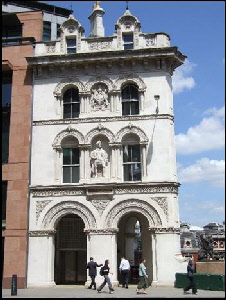This chap was Sir William Walworth. He was lord mayor of London in the late 1300s, during the reign of Richard II. Washington Irving said of him: “That doughty champion, William Walworth, knight, who so manfully clove down the sturdy wight, Wat Tyler, in Smithfield; a hero worthy of honourable blazon, as almost the only Lord Mayor on record famous for deeds of arms:- the sovereigns of Cockney being generally renowned as the most pacific of all potentates.” You will remember Wat Tyler from your high school history as the leader of the Peasants’ Revolt, a group protesting a Medieval poll tax. In those days, protest was regarded as treason and therefore a capital offence. The group fought its way into London to see the king, who offered to meet them in Smithfield.
After Wat Tyler had given his demands to the king, Sir William mortally wounded him, and then later dragged him from his death bed in St Bartholomew’s Hospital and beheaded him. “Thus ending his miserable life,” said the chronicler. Tyler was, after all, only a peasant. The king gave everyone in the protest a pardon and let them disperse, even escorting the Kentish contingent over London Bridge to ensure safe passage. He then send “messengers” all over England to hunt for and summarily execute all the peasants who were in the revolt in London that day. Walworth was awarded a knighthood and a pension and it is his dagger which is in the left-hand corner of St George’s cross, which is the emblem for London City. Dick Whittington was Lord Mayor very soon afterwards.
This beautiful and elegant Victorian bridge (below) over Farringdon St is Holborn Viaduct. Sir William’s statue stands on the first floor (see below) of the stone building above the stairs.
Sir William was a member, as was his father, of the Fishmongers Guild, from which he rose to be alderman and then mayor. He was buried in St Michaels Church, Crooked Lane, which was destroyed by the Great Fire. The replacement Wren church was demolished in 1831 to make way for King William St, which takes you from London Bridge up onto Cheapside. I have asked all the churches in the area and no-one knows where he lies now, nor where his memorial is.
This is Walworth House, and there are three identical buildings on Holborn Viaduct sitting as guardians of the stairs down to Farringdon Rd.



